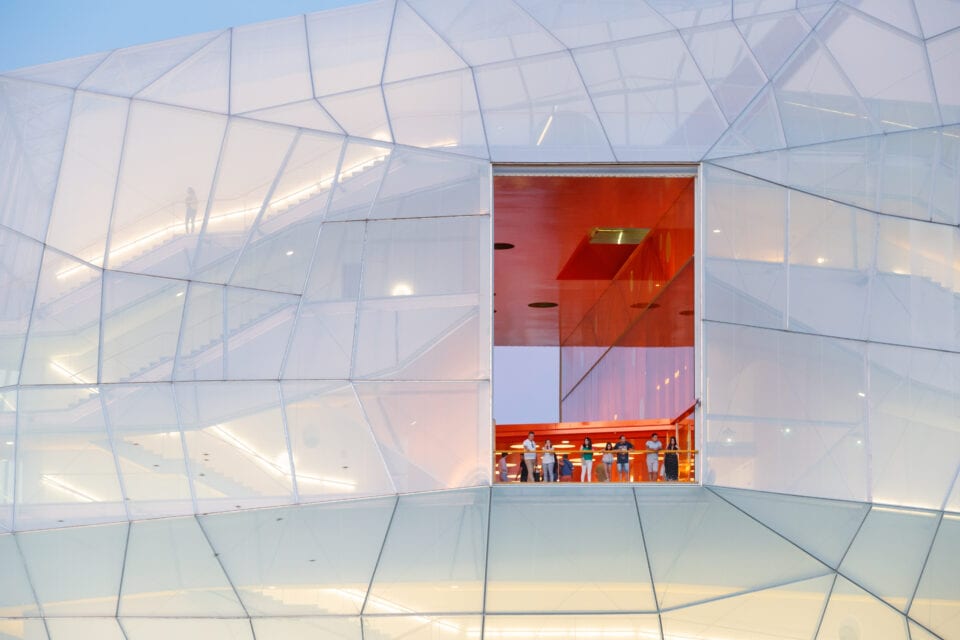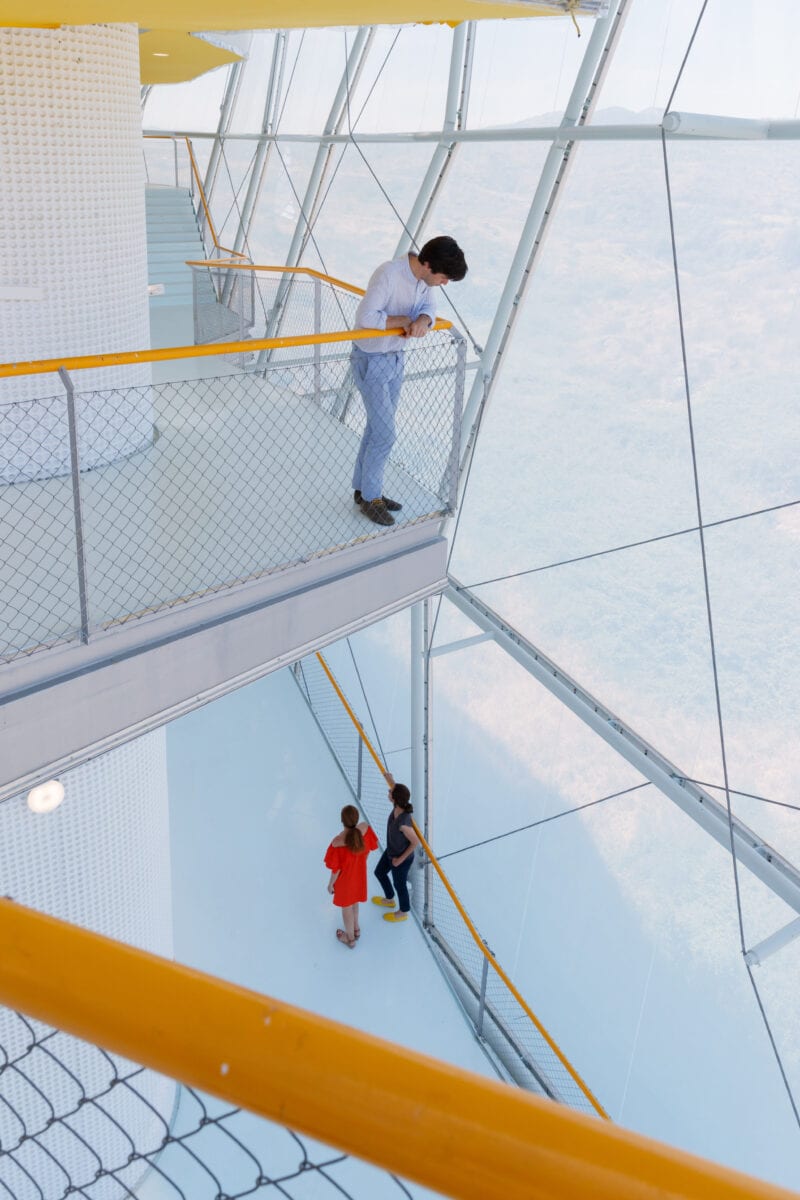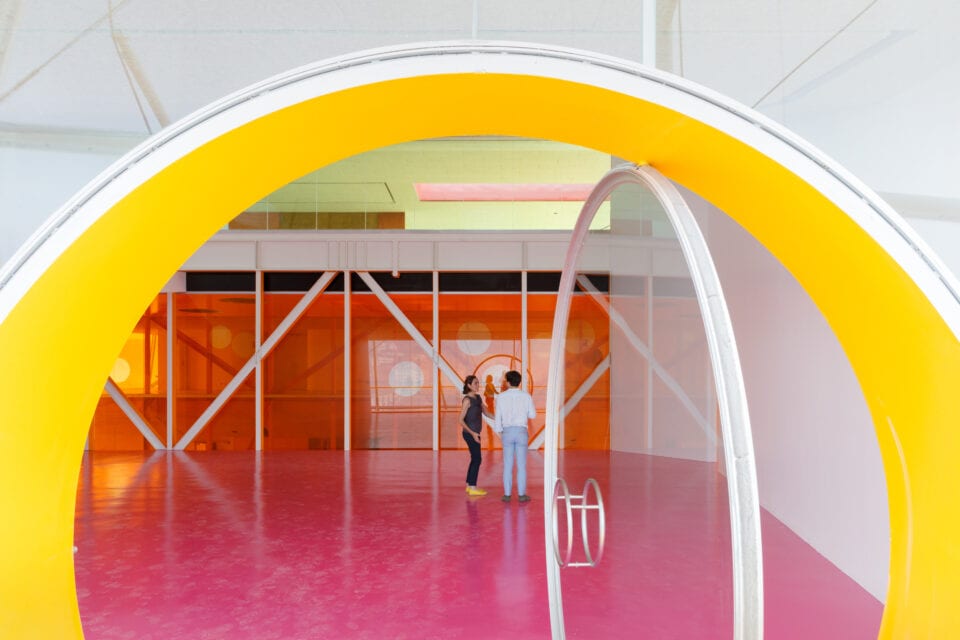Radical Architecture of the Future
Today’s creative architects aren’t just designing buildings, they’re working across various disciplines to grapple with ecological responsibility.
On a patch of scrubby hillside in western Spain is the Plasencia Auditorium and Conference Center. It sits like an extra- terrestrial landing capsule – a strange geomorphic play on the landscape. It emerges from the surroundings whilst look- ing completely alien to them, making such light contact with the ground that it seems it could take off any moment.
Architecture critic and curator Beatrice Galilee (b. 1982) de- scribes the building as “part chrysalis, part meteorite – an extraordinary luminous centre designed by wrapping all of the functions of a theatre, a dance hall, an exhibition space and conference auditoriums into a tight ball.” Created by Spanish firm SelgasCano, the Plasencia Auditorium was designed to make as small a footprint as possible in every sense. Of the building’s 86,000-square-foot volume, only 4,300 feet touch the ground, whilst the translucent “skin” – made of the durable, air-filled plastic ETFE – is self-cleaning and easy to install, barely adding any weight to construction and offer- ing up to 45 per cent reductions in solar heat gain.

The Plasencia Auditorium is one of 79 projects selected by Galilee for Radical Architecture of the Future, which maps out a bold route forward. “You could also call it ‘radical ways of thinking about architecture’”, she notes, a necessary qualification, given that, under Galilee’s stewardship, “architecture” incorporates everything from game design to community activism, inhabitants including insects and data. “It’s provocative to think that all of these myriad disciplines have architectural agency, but they all represent different ways of working with space,” she says. What binds these endeavours together, Galilee suggests, is their creative or critical intervention into the physical and sensory world, or our perception of it.
There are western precedents for Galilee’s radically expanded understanding of design, from the counter-cultural firms of the 1960s – Archigram, Ant Farm – to the intermedia ethos of 1910s-1920s Constructivism. But don’t call the work in her book modernist, Galilee warns (or post-modernist, or anti-modernist). “If it’s a reaction to modernism then that puts modernism at the centre, and that’s something I’m trying to step away from to decolonise my thinking … Central Europe doesn’t need to be so present in the discourse.”
Her career shows a commitment to widening and democratising discussions and definitions of architectural practice that matches this aim, in particular her work from 2014 to 2019 as a curator at the Metropolitan Museum of Art, New York, where she initiated In Our Time: A Year of Architecture in a Day, an annual conference presenting the developments in the discipline. She now runs The World Around, a platform for three-dimensional design focused on the expertise of artists and activists to solve social and environmental issues.
This is not to say that the radical architecture Galilee is interested in represents a bland, globally homogenous vision. The work she showcases reveals a deep sensitivity to the particularities of place and space, in a way which indicates just how many cultures and locations Galilee has connected with as a writer and curator. Freddy Mamani’s New Andean Architecture, for example, has transformed swathes of his adopted hometown of El Alto, Bolivia, into a panorama of technicolour abstraction. Mamani’s designs have a vivid appeal that easily crosses cultural boundaries, but they are rooted in the visual imagery of his Aymara people, a historically op- pressed ethnic group that makes up a quarter of Bolivia’s population (and the majority of El Alto’s).

Just as Mamani’s startling designs are the product of a profound connection to place, other designs offer futuristic variations on regional cultures. The Fuyang Cultural Complex, near the Chinese city of Hangzhou, was created by Amateur Architecture Studio using construction mate- rials common in the nearby village of Wencun, including rammed earth and crushed rubble, and was inspired by the landscape paintings of a 14th century Yuan Dynasty artist. The bright limestone walls of the Palestinian Museum, in the West Bank city of Ramallah, are built on the ruins of fieldstone walls once used by local farmers, whilst the jet-black window shades and angular contours of the site respond to its shape through agriculture. It’s this kind of awareness of historical and social context that prevents de- signers from lapsing into a eurocentric mindset.
In many cases, attention to the locale also means working directly with communities to improve their economic and social circumstances. Mamani’s first undertaking in El Alto was a cultural centre funded by micro-loans, whilst Amateur Architecture only agreed to build the complex at Fuyang if the regional government also funded the restoration of Wencun, which, like many remote Chinese villages, had experienced significant depopulation and fallen into disrepair as a result of China’s turbo-powered urbanisation. The Palestinian Museum – designed by Irish / German firm Heneghan Peng – is the base for a humanitarian group supporting Palestinian communities in the West Bank and Gaza strip, in addition to Lebanese refugee camps.
This relates to another key quality of radical architecture: sustainability. Sometimes this means ensuring that buildings have a harmonious – rather than parasitic – relation- ship with local cultures and economies, but the term also has a more obvious, ecological thrust. At the root of much radical architectural thinking is a concern with finding the most efficient, least exploitative way of using materials, energy and labour. This has led some practitioners away from building altogether – more towards the preservation and reuse of existing structures and materials.
Opalis, for example, is an online directory of retailers trading in salvaged materials created by the Belgian firm Rotor DC to mitigate the wasteful effects of renovation and demolition. Rotor assists first-hand with the repurposing of materials such as tiles, window frames, concrete panels and steel pipes (the manufacture of concrete alone generates around eight per cent of global carbon dioxide emissions.)

If forward-thinking designers are asking themselves if they must build at all, the scope of architecture becomes far more expansive than simply signing off on construction plans. Indeed, Interdisciplinarity is another thread that runs throughout Galilee’s methodology. Working with the lexicon of performance art as much as building design, the Mexican Firm Lab.Pro.Fab launches initiatives such as Aerial Domesticity, a “happening” in a Mexico City square that recreated the typical interior spaces of mass-housing schemes by placing them in transparent pods on cherry-pickers, giving viewers an insight into cramped living conditions.
Meanwhile, Diller Scofidio + Renfro’s Mile-Long Opera utilised the unusual shape of New York’s High Line park, located on a former railway line, to stage an eight-night spectacle combining design, music and poetry. Composer David Lang and poets Anne Carson and Claudia Rankine helped the team to script and score the work, whose per- formers, stretched along the 2.5-kilometre length of the park, repeated sections of a libretto based on interviews with New Yorkers from a range of backgrounds.
In other cases, an intermedia focus means retreating from physical space altogether. Many designers are now creating virtual worlds using technology which can be inhabited with as much sensory and emotional investment as any physical structure. Chinese artist Cao Fei, for example, used the immersive computer game Second Life to create her own online world, RMB City, a satirical shadow-realm crammed with the stereotypical features of modern China, from identikit skyscrapers to souvenirs and shopping malls.

Based on a similar formal conceit but in a different spirit, production designer Hannah Beachler’s realisation of Wa- kanda, the fictional African home of Marvel super-hero Black Panther, is based on projections of how the visual cultures and economies of countries such as Senegal, Kenya and Uganda might have developed had they not been colonised. The Vault of Life, by Seoul-based firm Mass Studies, envisages a new ecology library and seed bank in the demilitarised zone between North and South Korea: which, because of the lack of human incursion, has become the unlikely home to a vast array of diverse wildlife.
In fact, much “radical architecture” is now made for non- human life: from AI to animals. Given the urgency of the questions we face about our relationship with the non-human world, from labour automation to the ongoing mass extinction event, three-dimensional design that embodies more equitable ways of living alongside non-human life might be the most radical of all. Junya Ishigami’s Art Biotop Water Garden in Nasu, Japan, for example, is an artificial water meadow containing 318 trees uprooted from a nearby section of land to make space for a hotel. Threaded with 160 artificial ponds and intersecting pathways, surrounded by moss and wildflowers, and irrigated by a subterranean network of pipes, this wetland glade is a hyperreal artificial environment. However, it is also a natural landscape, with micro-habitats for insects and indigenous fauna. This space demonstrates how our intervention with ecosystems can offer preservation rather than destruction.
So, how optimistic should we feel about the ability of architecture, in Galilee’s expanded sense, to solve the problems that it also exposes, with regards to the environment, economy and society as a whole? She is cautiously hopeful on this front: “In the past, people have turned to architects as civic and thought leaders, and I think that they can lead on these issues. Right now, it isn’t, but it could.”
Galilee points to Eyal Weizman’s Forensic Architecture, which uses sophisticated technologies such as detailed three-dimensional modelling – alongside documentary research and interviews – to visualise human rights violations around the world, including violence committed by states, police forces, militaries and corporations. “Who could have imagined that architects would be on the forefront of thinking about human rights abuses and interstate conflicts. We’ve got some really good ideas.” Galilee’s methodology, at its best, can show us how to live in more sustainable, empathetic, site-specific ways – with a clearer sense of our responsibilities to the non-human world.
Words
Greg Thomas
Radical Architecture of the Future is published by Phaidon this January.
Lead Image: Photo: Iwan Baan – Selgas Cano, Plasencia Auditorium and Congress Center, Plasencia, Spain
Images 1-4: Photo: Iwan Baan – Selgas Cano, Plasencia Auditorium and Congress Center, Plasencia, Spain.





